Integration of Soil Electrical Conductivity and Indices Obtained through Satellite Imagery for Differential Management of Pasture Fertilization
Abstract
:1. Introduction
2. Materials and Methods
2.1. Experimental Field
2.2. Digital Elevation Model (Altimetry)
2.3. Soil ECa Measurements
2.4. Soil Sample Collection and Analysis
2.5. Pasture Sample Collection and Analysis
2.6. Vegetation Multispectral Measurements by Remote Sensing
2.7. Statistical Analysis of the Data
3. Results
3.1. Spatial Variability
3.2. Management Classes: Spatial Variability and Temporal Stability
3.3. Site-Specific Management
4. Discussion
4.1. Spatial Variability
4.2. Management Classes: Spatial Variability and Temporal Stability
4.3. Site-Specific Management and Fertilizer Prescription Maps
5. Conclusions
Author Contributions
Funding
Acknowledgments
Conflicts of Interest
References
- Yuan, X.; Chai, X.; Gao, R.; He, Y.; Jin, H.; Huang, Y. Temporal and spatial variability of soil organic matter in a county scale agricultural ecosystem. N. Z. J. Agr. Res. 2007, 50, 1157–1168. [Google Scholar] [CrossRef]
- Schellberg, J.; Hill, M.J.; Gerhards, R.; Rothmund, M.; Braun, M. Precision agriculture on grassland: Applications, perspectives and constraints. Eur. J. Agron. 2008, 29, 59–71. [Google Scholar] [CrossRef]
- Serrano, J.; Shahidian, S.; Marques da Silva, J.; Sales-Baptista, E.; Ferraz de Oliveira, I.; Lopes de Castro, J.; Pereira, A.; Cancela de Abreu, M.; Machado, E.; Carvalho, M. Tree influence on soil and pasture: Contribution of proximal sensing to pasture productivity and quality estimation in montado ecosystems. Int. J. Remote Sens. 2018, 39, 4801–4829. [Google Scholar] [CrossRef]
- Benavides, R.; Douglas, G.B.; Osoro, K. Silvopastoralism in New Zealand: Review of effects of evergreen and deciduous trees on pasture dynamics. Agrofor. Syst. 2009, 76, 327–350. [Google Scholar] [CrossRef]
- Castrignanò, A.; Buttafuoco, G.; Quarto, R.; Vitti, C.; Langella, G.; Terribile, F.; Venezia, A. A combined approach of sensor data fusion and multivariate geostatistics for delineation of homogeneous zones in an agricultural field. Sensors 2017, 17, 2794. [Google Scholar] [CrossRef]
- Moral, F.; Terrón, J.; Da Silva, J.M. Delineation of management zones using mobile measurements of soil apparent electrical conductivity and multivariate geostatistical techniques. Soil Tillage Res. 2010, 106, 335–343. [Google Scholar] [CrossRef]
- Georgi, C.; Spengler, D.; Itzerott, S.; Kleinschmit, B. Automatic delineation algorithm for site-specific management zones based on satellite remote sensing data. Precis. Agric. 2018, 19, 684–707. [Google Scholar] [CrossRef]
- Peralta, N.R.; Costa, J.L. Delineation of management zones with soil apparent electrical conductivity to improve nutrient management. Comput. Electron. Agric. 2013, 99, 218–226. [Google Scholar] [CrossRef]
- Serrano, J.; Peça, J.; Marques da Silva, J.; Shahidian, S. Mapping soil and pasture variability with an electromagnetic induction sensor. Comput. Electron. Agric. 2010, 73, 7–16. [Google Scholar] [CrossRef]
- Serrano, J.; Shahidian, S.; Marques da Silva, J. Evaluation of normalized difference water index as a tool for monitoring pasture seasonal and inter-annual variability in a Mediterranean agro-silvo-pastoral system. Water 2019, 11, 62. [Google Scholar] [CrossRef]
- Gebremedhin, A.; Badenhorst, P.E.; Wang, J.; Spangenberg, G.C.; Smith, K.F. Prospects for measurement of dry matter yield in forage breeding programs using sensor technologies. Agronomy 2019, 9, 65. [Google Scholar] [CrossRef]
- Chai, X.; Zhang, T.; Shao, Y.; Gong, H.; Liu, L.; Xie, K. Modeling and mapping soil moisture of plateau pasture using RADARSAT-2 imagery. Remote Sens. 2015, 7, 1279–1299. [Google Scholar] [CrossRef]
- Serrano, J.; Shahidian, S.; Marques da Silva, J. Monitoring seasonal pasture quality degradation in the Mediterranean montado ecosystem: Proximal versus remote sensing. Water 2018, 10, 1422. [Google Scholar] [CrossRef]
- Jackson, T.J.; Chen, D.; Cosh, M.; Li, F.; Anderson, M.; Walthall, C.; Doriaswamy, P.; Hunt, E.R. Vegetation water content mapping using Landsat data derived normalized difference water index for corn and soybeans. Remote Sens. Environ. 2004, 92, 475–482. [Google Scholar] [CrossRef]
- Nawar, S.; Corstanje, R.; Halcro, G.; Mulla, D.; Mouazen, A.M. Delineation of soil management zones for variable-rate fertilization: A review. Adv. Agron. 2017, 143, 175–245. [Google Scholar]
- Sánchez-Ruiz, S.; Piles, M.; Sánchez, N.; Martínez-Fernández, J.; Vall-llossera, M.; Camps, A. Combining SMOS with visible and near/shortwave/thermal infrared satellite data for high resolution soil moisture estimates. J. Hidrol. 2014, 516, 273–283. [Google Scholar] [CrossRef]
- Wang, X.; Fuller, D.O.; Setemberg, L.; Miralles-Wilhelm, F. Foliar nutrient and water content in subtropical tree islands: A new chemo hydro dynamic link between satellite vegetation indices and foliar δ 15N values. Remote Sens. Environ. 2011, 3, 923–930. [Google Scholar] [CrossRef]
- Gao, B.-C. NDWI—A normalized difference water index for remote sensing of vegetation liquid water from space. Remote Sens. Environ. 1996, 58, 257–266. [Google Scholar] [CrossRef]
- FAO. World Reference Base for Soil Resources; Food and Agriculture Organization of the United Nations, World Soil Resources Reports N 103; FAO: Rome, Italy, 2006. [Google Scholar]
- AOAC. Official Method of Analysis of AOAC International, 18th ed.; AOAC International: Arlington, AT, USA, 2005. [Google Scholar]
- Blackmore, S. The interpretation of trends from multiple yield maps. Comput. Electron. Agric. 2000, 26, 37–51. [Google Scholar] [CrossRef]
- Xu, H.-W.; Wang, K.; Bailey, J.; Jordan, C.; Withers, A. Temporal stability of sward dry matter and nitrogen yield patterns in a temperate grassland. Pedosphere 2006, 16, 735–744. [Google Scholar] [CrossRef]
- ESRI (Environmental Systems Research Institute) Inc. ArcView 9.3 GIS Geostatistical Analyst; ESRI: Redlands, CA, USA, 2009. [Google Scholar]
- Serrano, J.; Shahidian, S.; Marques da Silva, J. Apparent electrical conductivity in dry versus wet soil conditions in a shallow soil. Precis. Agric. 2013, 14, 99–114. [Google Scholar] [CrossRef]
- Carvalho, M.; Goss, M.J.; Teixeira, D. Manganese toxicity in Portuguese Cambisols derived from granitic rocks: Causes, limitations of soil analyses and possible solutions. Revista de Ciências Agrárias 2015, 38, 518–527. [Google Scholar] [CrossRef]
- Mallarino, A.P.; Wittry, D.J. Efficacy of grid and zone soil sampling approaches for site-specific assessment of phosphorus, potassium, pH, and organic matter. Precis. Agric. 2004, 5, 131–144. [Google Scholar] [CrossRef]
- Marques da Silva, J.R.; Peça, J.O.; Serrano, J.M.; Carvalho, M.J.; Palma, P.M. Evaluation of spatial and temporal variability of pasture based on topography and the quality of the rainy season. Precis. Agric. 2008, 9, 209–229. [Google Scholar] [CrossRef]
- Serrano, J.; Peça, J.; Marques da Silva, J.; Shahidian, S. Spatial and temporal stability of soil phosphate concentration and pasture dry matter yield. Precis. Agric. 2011, 12, 214–232. [Google Scholar] [CrossRef]
- Zhao, F.; Xu, B.; Yang, X.; Jin, Y.; Li, J.; Xia, L.; Chen, S.; Ma, H. Remote sensing estimates of grassland aboveground biomass based on MODIS net primary productivity (NPP): A case study in the Xilingol grassland of Northern China. Remote Sens. 2014, 6, 5368–5386. [Google Scholar] [CrossRef]
- Trotter, M.G.; Lamb, D.W.; Donald, G.E.; Schneider, D.A. Evaluating an active optical sensor for quantifying and mapping green herbage mass and growth in a perennial grass pasture. Crop Pasture Sci. 2010, 61, 389–398. [Google Scholar] [CrossRef]
- Lumbierres, M.; Méndez, P.F.; Bustamante, J.; Soriguer, R.; Santamaria, L. Modeling biomass production in seasonal wetlands using Modis NDVI land surface phenology. Remote Sens. 2017, 9, 392. [Google Scholar] [CrossRef]
- Schaefer, M.T.; Lamb, D.W. A combination of plant NDVI and Lidar measurements improve the estimation of pasture biomass in Tall Fescue (Festuca Arundinacea Var. Fletcher). Remote Sens. 2016, 8, 109. [Google Scholar] [CrossRef]
- Serrano, J.; Shahidian, S.; Marques da Silva, J. Calibration of GrassMaster II to estimate green and dry matter yield in Mediterranean pastures: Effect of pasture moisture content. Crop Pasture Sci. 2016, 67, 780–791. [Google Scholar] [CrossRef]
- Pullanagari, R.; Yule, I.; Tuohy, M.; Hedley, M.; Dynes, R.; King, W. Proximal sensing of the seasonal variability of pasture nutritive value using multispectral radiometry. Grass Forage Sci. 2013, 68, 110–119. [Google Scholar] [CrossRef]
- Albayrak, S. Use of reflectance measurements for the detection of N, P, K, ADF and NDF contents in Sainfoin pasture. Sensors 2008, 8, 7275–7286. [Google Scholar] [CrossRef] [PubMed] [Green Version]
- Efe Serrano, J. Pastures in Alentejo: Technical basis for Characterization, Grazing and Improvement; Universidade de Évora—ICAM, Ed.; Gráfica Eborense: Évora, Portugal, 2006; pp. 165–178. [Google Scholar]
- Sims, J.T.; Leytem, A.B.; Gartley, K.L. Interpreting Soil Phosphorus Tests; Department of Plant and Soil Sciences, College of Agriculture and Natural Resources, University of Delaware; DE: Newark, NJ, USA, 2002; p. 5. [Google Scholar]
- Serrano, J.; Peça, J.; Marques da Silva, J.; Shahidian, S.; Carvalho, M. Phosphorus dynamics in permanent pastures: Differential fertilizing and the animal effect. Nutr. Cycl. Agroecosys. 2011, 90, 63–74. [Google Scholar] [CrossRef]



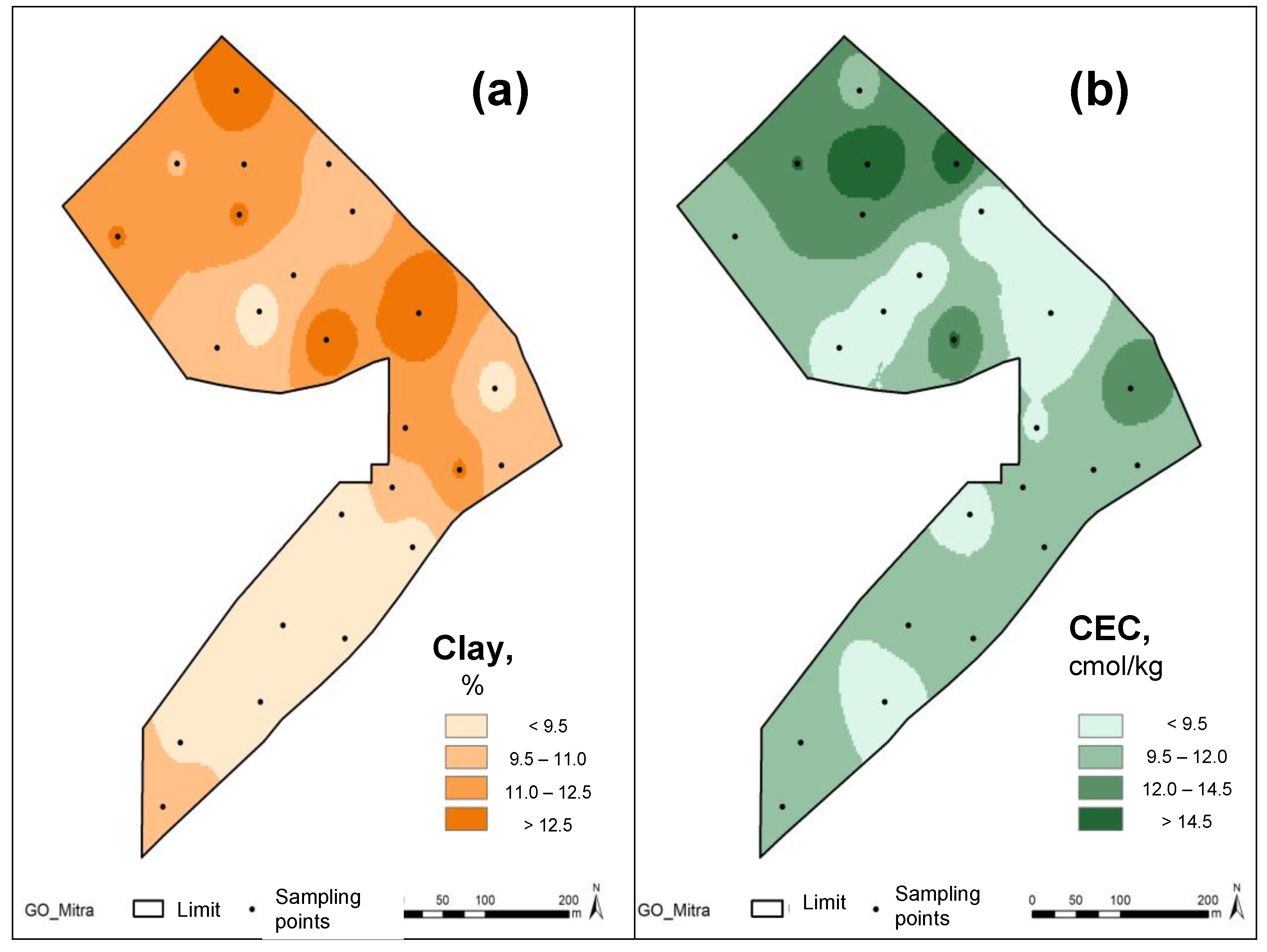
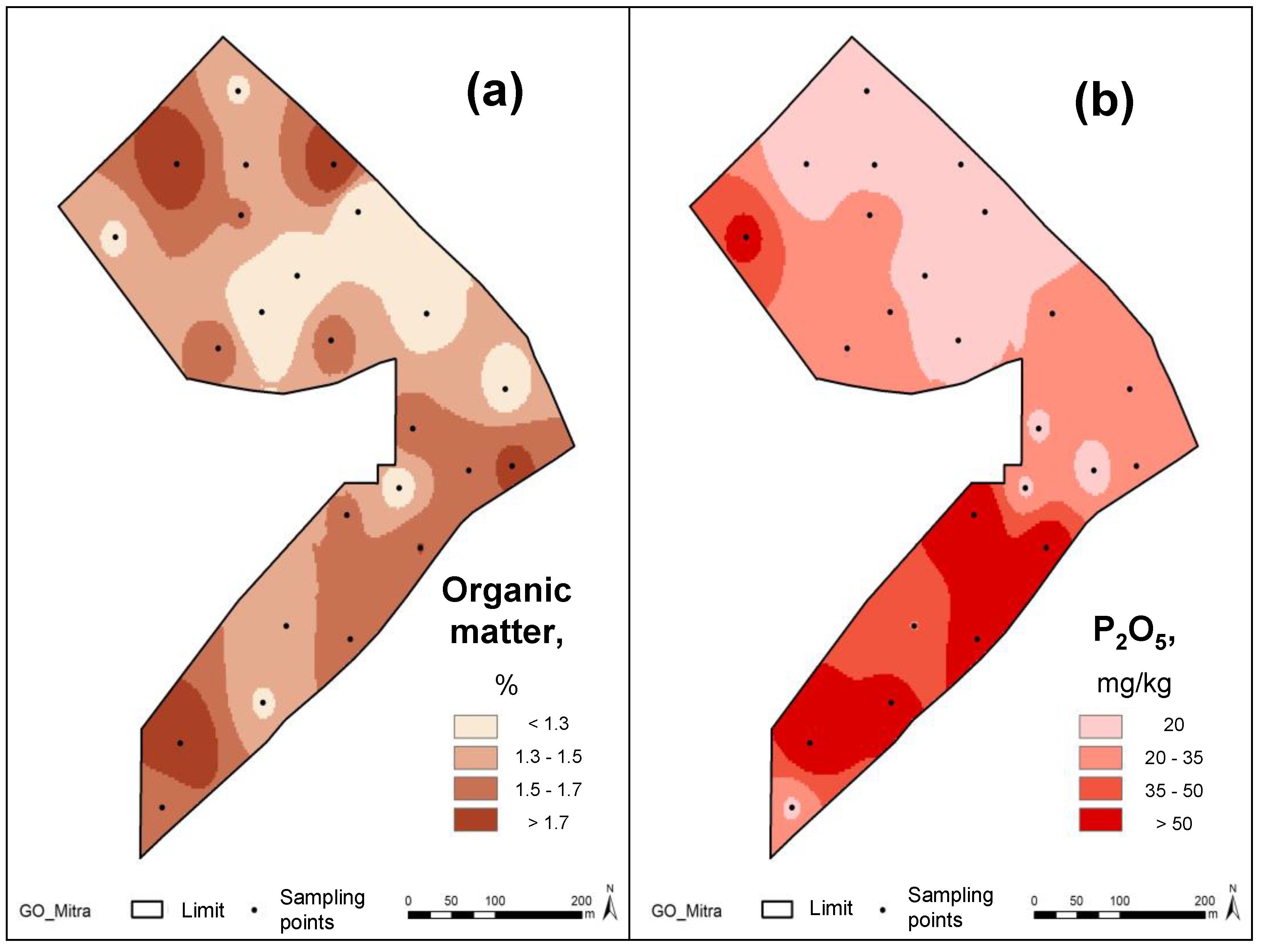

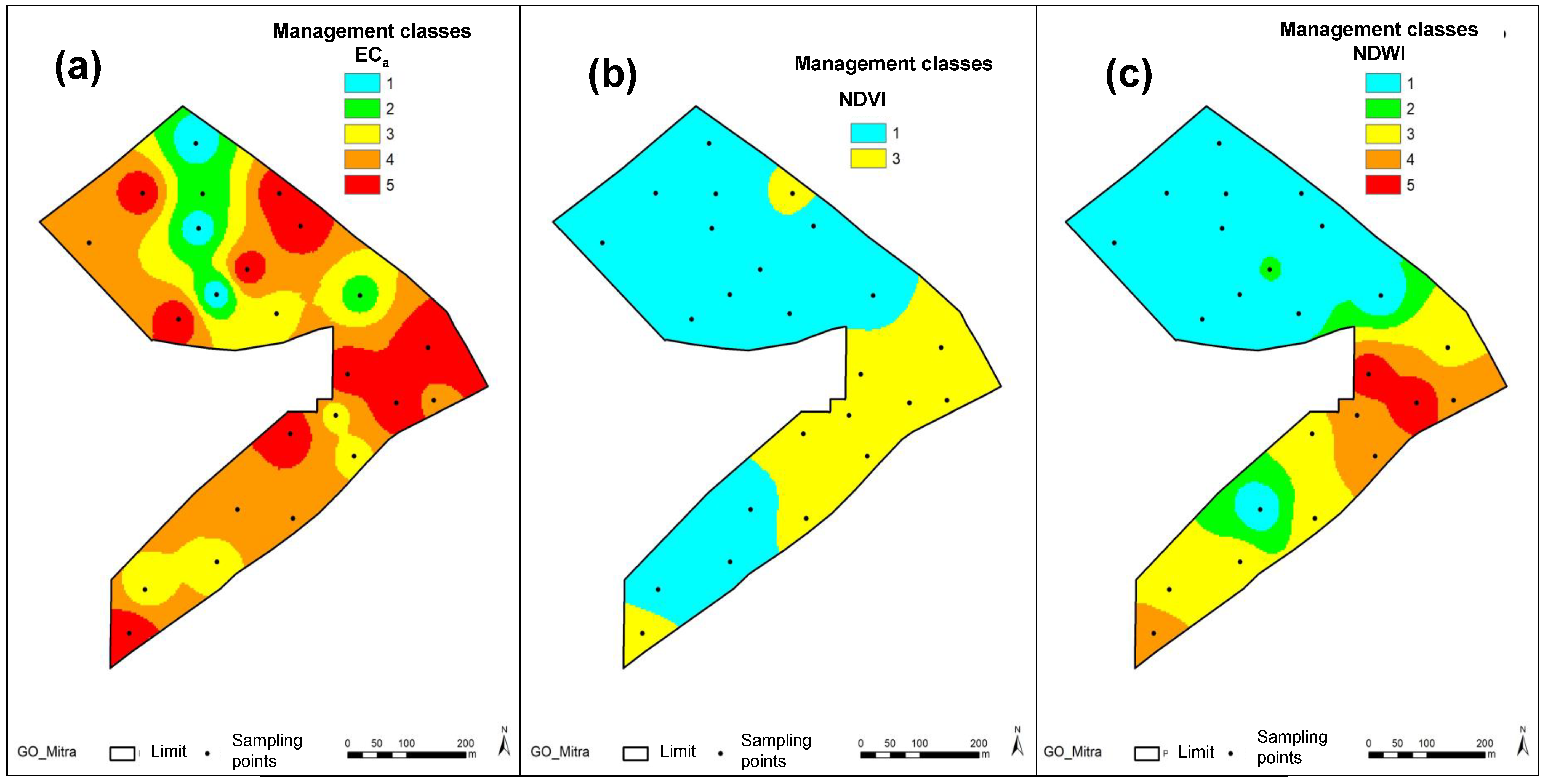
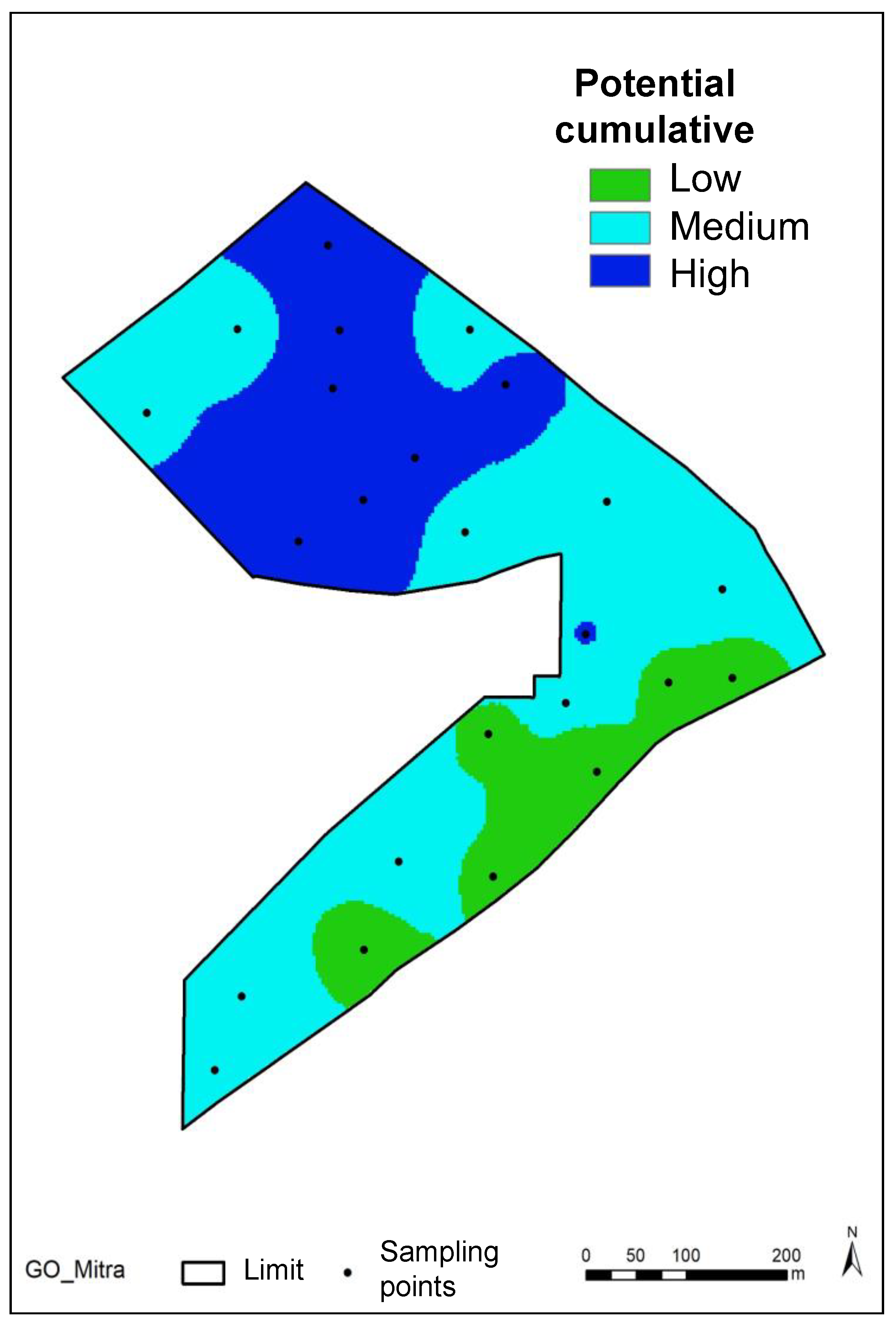

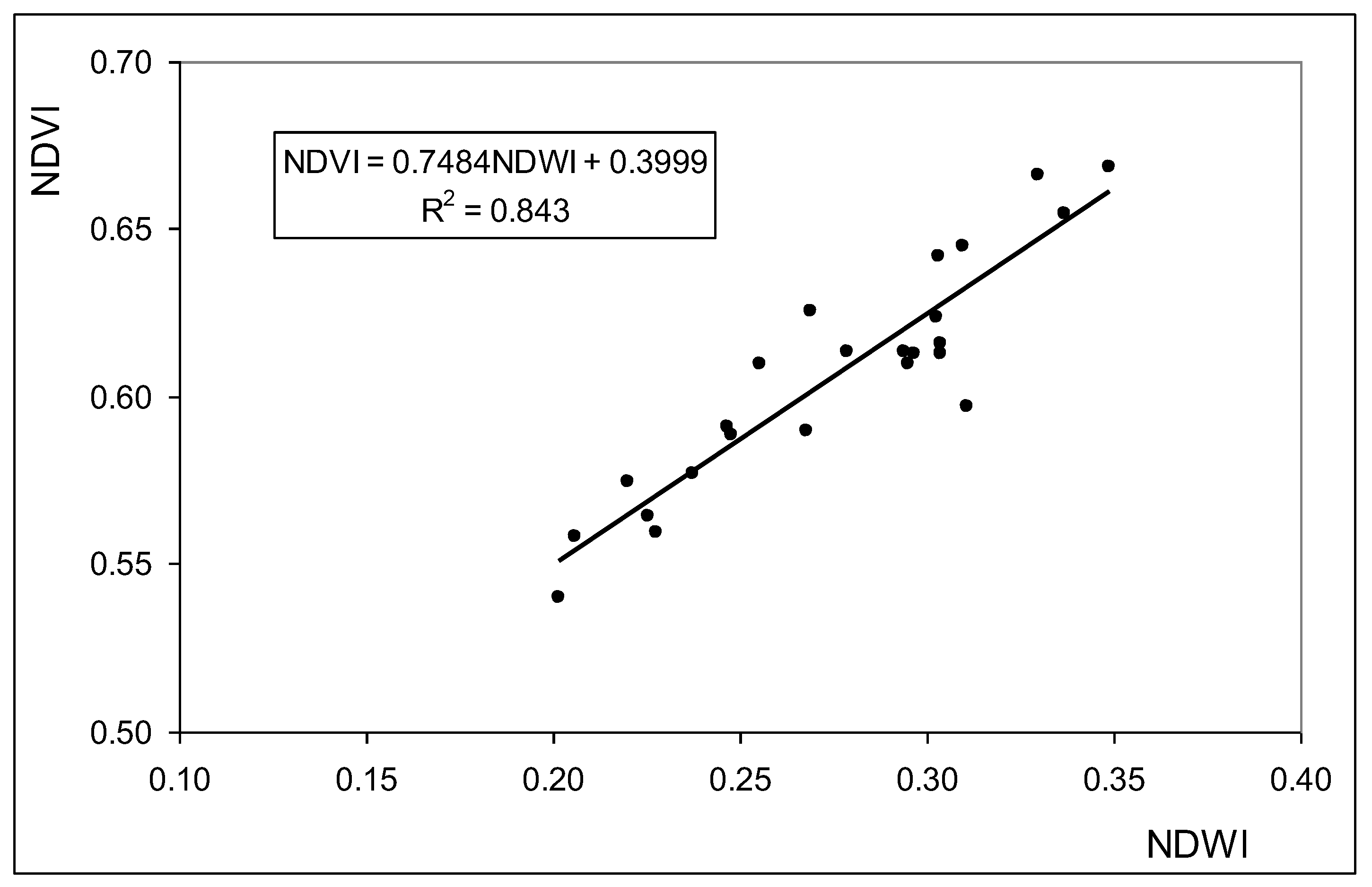
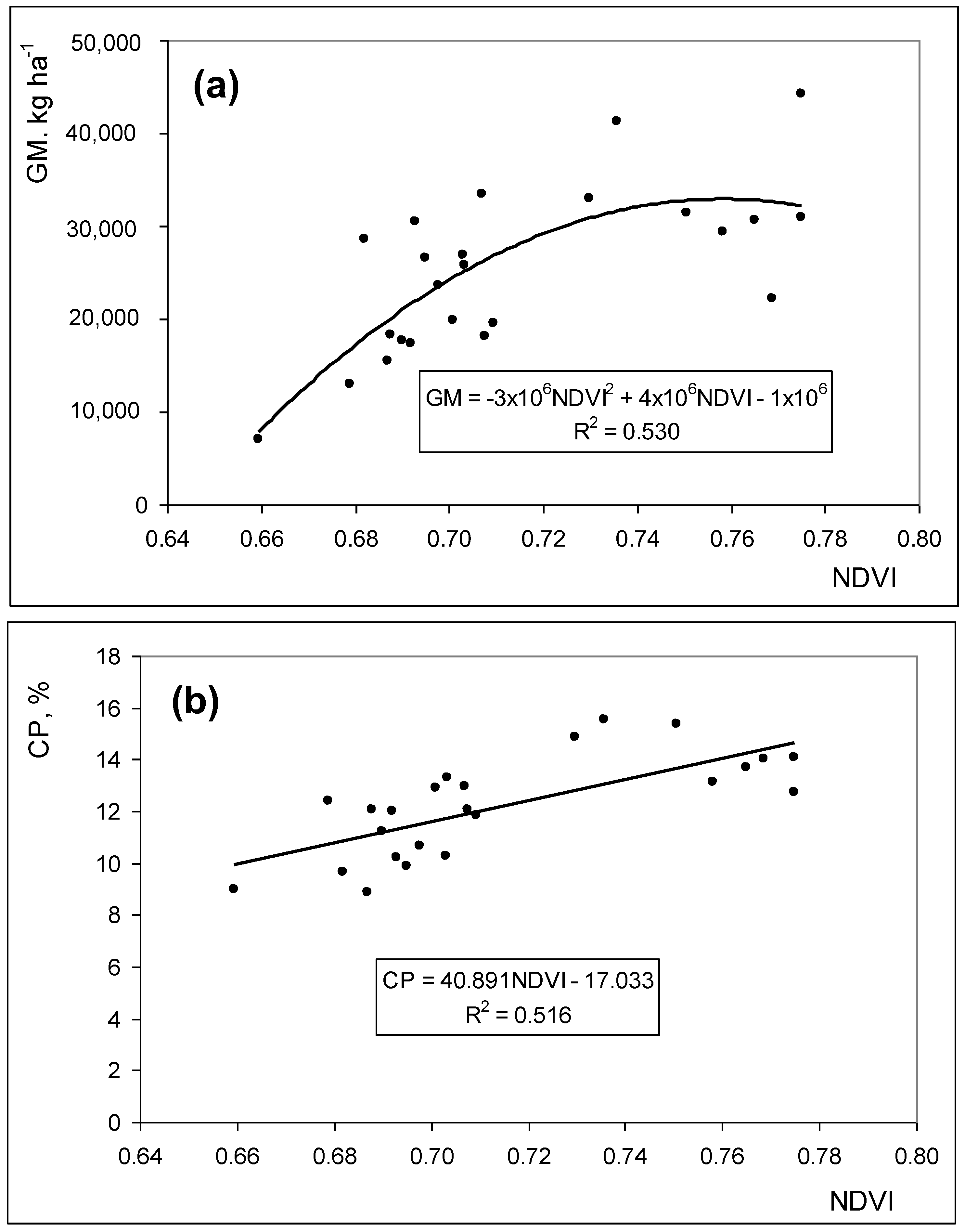
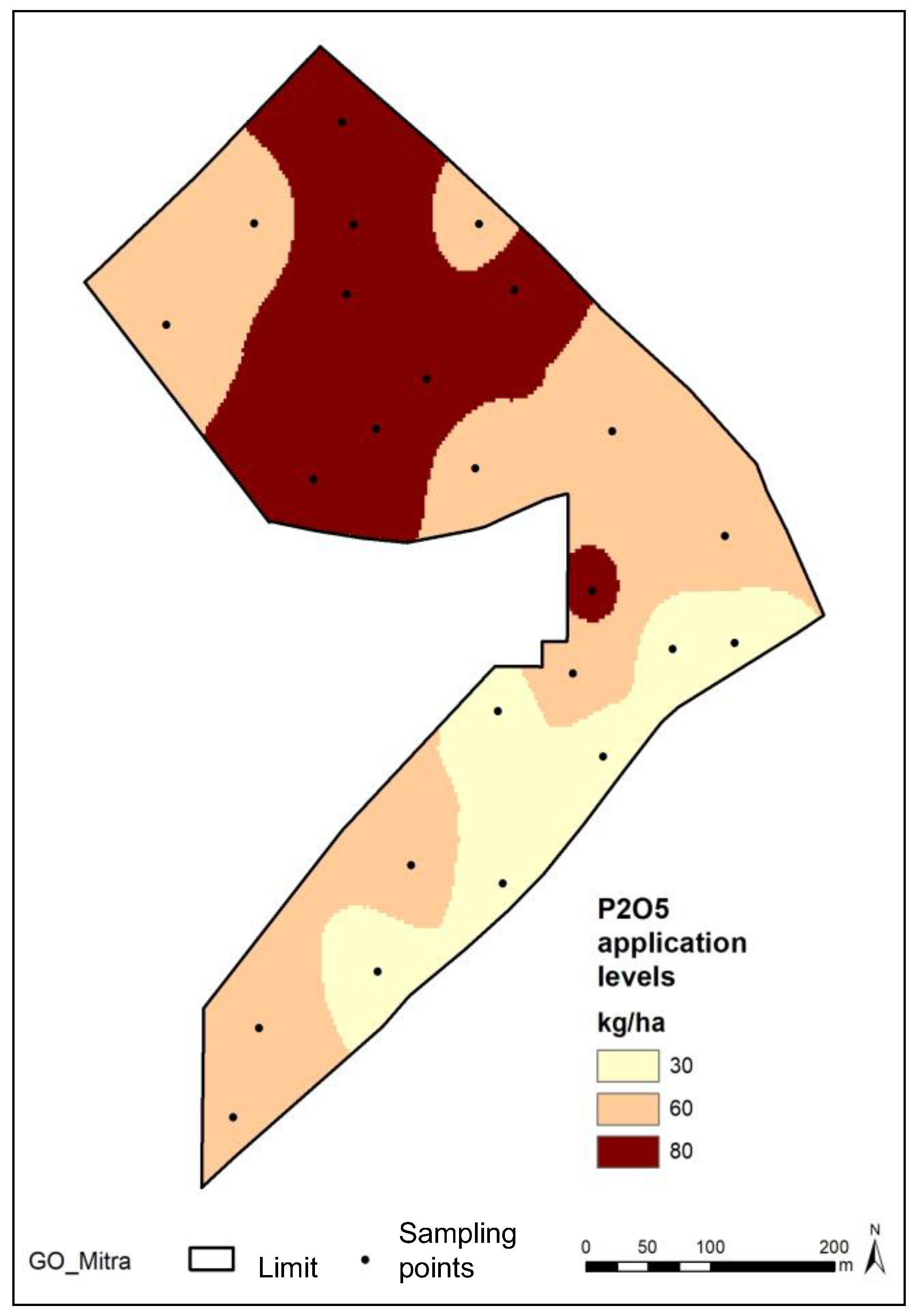
| Parameter (Date) | Mean | SD | CV | Range |
|---|---|---|---|---|
| Soil (November/2017) | ||||
| ECa. mS m−1 | 2.3 | 1.3 | 55.4 | 0.8–5.5 |
| SMC, % | 9.4 | 1.8 | 18.6 | 7.4–12.5 |
| Sand, % | 78.4 | 4.0 | 5.0 | 71.5–84.6 |
| Silt, % | 11.2 | 2.2 | 19.9 | 7.4–15.3 |
| Clay, % | 10.4 | 1.8 | 17.3 | 7.2–13.9 |
| Organic matter, % | 1.5 | 0.3 | 21.5 | 0.9–2.1 |
| pH | 5.5 | 0.2 | 4.4 | 5.0–5.8 |
| P2O5, mg kg−1 | 32.6 | 21.5 | 65.8 | 7.8–81.0 |
| K2O, mg kg−1 | 94.0 | 72.1 | 76.7 | 81.0–380.0 |
| Magnesium (Mg), mg kg−1 | 57.7 | 25.3 | 43.8 | 15.0–120.0 |
| Manganese (Mn), mg kg−1 | 33.0 | 18.0 | 54.4 | 15.0–87.0 |
| CEC, cmol kg−1 | 10.8 | 2.8 | 26.4 | 5.2–17.9 |
| Remote Sensing (December 2016–June 2017 and December 2017–June 2018) | ||||
| NDVI | 0.606 | 0.034 | 5.6 | 0.540–0.669 |
| NDWI | 0.276 | 0.042 | 15.2 | 0.202–0.349 |
| Pasture (May/2018) | ||||
| Green matter, kg ha−1 | 25,188 | 8776 | 34.8 | 7000–44,200 |
| Dry matter, kg ha−1 | 3946 | 1053 | 26.7 | 1400–5700 |
| Crude proteín, % | 12.1 | 1.9 | 15.6 | 8.9–15.5 |
| NDF, % | 51.4 | 3.6 | 7.0 | 45.7–58.0 |
| Soil (October/2018) | ||||
| ECa. mS m−1 | 1.8 | 0.9 | 50.0 | 0.6–3.7 |
| SMC, % | 7.9 | 1.0 | 12.5 | 6.4–9.8 |
| Parameter | MZ–Low Potential | MZ–Medium Potential | MZ–High Potential | |||
|---|---|---|---|---|---|---|
| (Date) | Mean | CV | Mean | CV | Mean | CV |
| Soil (November/2017) | ||||||
| ECa. mS m−1 | 1.5 | 22.2% | 1.7 | 29.0% | 3.6 | 16.1% |
| SMC, % | 8.4 | 15.1% | 9.5 | 18.2% | 9.5 | 15.2% |
| Sand, % | 80.3 | 4.9% | 77.7 | 5.3% | 77.8 | 4.9% |
| Silt, % | 10.4 | 12.3% | 11.6 | 13.5% | 11.4 | 11.0% |
| Clay, % | 9.3 | 12.0% | 10.7 | 12.7% | 10.8 | 11.1% |
| Organic matter, % | 1.6 | 10.9% | 1.6 | 14.0% | 1.3 | 11.0% |
| pH | 5.6 | 4.5% | 5.4 | 4.2% | 5.5 | 4.2% |
| P2O5, mg kg−1 | 53.2 | 36.8% | 30.1 | 45.3% | 21.6 | 34.1% |
| K2O, mg kg−1 | 93.7 | 41.3% | 106.8 | 53.7% | 78.3 | 36.5% |
| Magnesium (Mg), mg kg−1 | 60.0 | 25.7% | 57.0 | 35.8% | 56.9 | 27.9% |
| Manganese (Mn), mg kg−1 | 25.3 | 26.3% | 39.6 | 43.2% | 30.6 | 28.4% |
| CEC, cmolc kg−1 | 10.2 | 14.0% | 10.5 | 18.3% | 11.4 | 15.7% |
| Remote Sensing (Winter and Spring 2017 and 2018) | ||||||
| NDVI | 0.573 | 4.3% | 0.618 | 4.8% | 0.617 | 5.1% |
| NDWI | 0.233 | 10.4% | 0.289 | 12.4% | 0.292 | 10.8% |
| Pasture (May/2018) | ||||||
| Green matter, kg ha−1 | 23,283 | 25.5% | 24,463 | 29.7% | 26,910 | 18.4% |
| Dry matter, kg ha−1 | 3633 | 20.1% | 3925 | 28.7% | 4150 | 18.0% |
| Crude protein, % | 12.0 | 13.9% | 11.4 | 14.0% | 12.7 | 10.5% |
| NDF, % | 49.9 | 4.1% | 51.6 | 7.5% | 52.3 | 4.7% |
| Soil (October/2018) | ||||||
| ECa. mS m−1 | 1.1 | 22.5% | 1.5 | 34.1% | 2.7 | 21.9% |
| SMC, % | 6.5 | 10.3% | 7.9 | 10.4% | 8.4 | 9.9% |
| Soil P2O5 Concentration, mg kg−1 | P2O5 Application Levels, kg ha−1 |
|---|---|
| [P2O5] < 30 | 80 |
| 30 ≤ [P2O5] < 50 | 60 |
| 50 ≤ [P2O5] < 80 | 30 |
| [P2O5] ≥ 80 | 0 |
© 2019 by the authors. Licensee MDPI, Basel, Switzerland. This article is an open access article distributed under the terms and conditions of the Creative Commons Attribution (CC BY) license (http://creativecommons.org/licenses/by/4.0/).
Share and Cite
Serrano, J.; Shahidian, S.; Marques da Silva, J.; Paixão, L.; Calado, J.; Carvalho, M.d. Integration of Soil Electrical Conductivity and Indices Obtained through Satellite Imagery for Differential Management of Pasture Fertilization. AgriEngineering 2019, 1, 567-585. https://0-doi-org.brum.beds.ac.uk/10.3390/agriengineering1040041
Serrano J, Shahidian S, Marques da Silva J, Paixão L, Calado J, Carvalho Md. Integration of Soil Electrical Conductivity and Indices Obtained through Satellite Imagery for Differential Management of Pasture Fertilization. AgriEngineering. 2019; 1(4):567-585. https://0-doi-org.brum.beds.ac.uk/10.3390/agriengineering1040041
Chicago/Turabian StyleSerrano, João, Shakib Shahidian, José Marques da Silva, Luís Paixão, José Calado, and Mário de Carvalho. 2019. "Integration of Soil Electrical Conductivity and Indices Obtained through Satellite Imagery for Differential Management of Pasture Fertilization" AgriEngineering 1, no. 4: 567-585. https://0-doi-org.brum.beds.ac.uk/10.3390/agriengineering1040041





